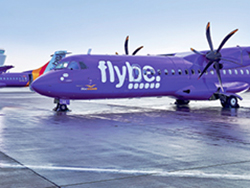 Earlier this year, former easyJet Director Paul Simmons joined Blue Islands’ board as a Non-Executive Director. Paul spent seven years with easyJet, initially as Group Head of Marketing and Distribution and for the last five years as UK Director. In this role, he was responsible for the commercial performance of easyJet’s UK fleet and consistently grew the profitability of the business.
Earlier this year, former easyJet Director Paul Simmons joined Blue Islands’ board as a Non-Executive Director. Paul spent seven years with easyJet, initially as Group Head of Marketing and Distribution and for the last five years as UK Director. In this role, he was responsible for the commercial performance of easyJet’s UK fleet and consistently grew the profitability of the business.
Prior to airlines, Paul held senior international marketing executive positions with blue-chip organisations in the FMCG and hospitality sectors, including P&G, Kellogg’s and InterContinental Hotels. He is currently CEO of Sequestim, a new airport security business co-owned by Cardiff University.
Paul has a strong understanding of regional aviation markets and, here, he offers his unique insight into a subject that stirs up many emotions across the Channel Islands – air connectivity.
The Channel Islands are wonderful places to live: stunning locations offering high employment, excellent education, lower taxes than the UK and low crime. We are served by telecoms, water, electricity and other utilities tailored to our local Channel Islands needs and, of course, transport infrastructure. Due to small markets on the islands, the organisations providing these services do not enjoy the scale of similar providers in the UK serving far larger demographics. That means the cost of procuring robust and resilient services for our islands is greater.
With financial services one of the islands’ largest industries, but an isolated travel market, the business community relies on connectivity provided by regional airlines to meet their immediate, time-sensitive needs by providing a choice of frequent daily flights throughout the year. Optimised schedules and multiple flights allow same-day travel if required, ensuring productivity when away from the office and reducing accommodation and sustenance expenses to satisfy ever stricter travel policies.
Sport is also part of the fabric of Channel Islands life, and sports teams know they can fulfil inter-insular and UK fixtures even in the winter and typically return on the same day – again, avoiding accommodation and sustenance expenses.
Guernsey and Jersey boast excellent healthcare provision but, inevitably, there is often a need for off-island treatment. High-frequency year-round services ensure that patients can rely on travel services to get them to the UK for appointments – and be able to return home the same day if treatment allows.
All of this also means we should be wary of ‘non-strategic’ new entrants, especially low-cost carriers (LCCs). As a former UK Director of the largest British LCC, I know how shorter routes are often used to optimise schedules until something better comes along. I did this myself with routes from the UK to the Isle of Man.
There is a clear danger that a longer runway at Guernsey, for example, would attract new entrants looking for short ‘filler’ routes – promising great things, demanding financial incentives and insisting on prime routes such as Gatwick – until they can find something ‘more useful’ to do with the aircraft.
During the time that they do operate, they will typically cherry-pick the best days and times to operate, and crash pricing. Although this may bring short-term benefits to the travelling public, in the medium term it destabilises the established regional airlines trying to provide regular, reliable lifeline services – leaving everyone in a worse off position – except the LCC.
 Scale and choice through alliances
Scale and choice through alliances
The costs of operating an airline are high. With sub-scale markets in Guernsey and Jersey, it is a challenge to balance the needs of serving the local communities with a route network that offers high frequency year-round services and ensuring that the business is sustainable to ensure long-term viability.
To successfully manage the high costs of operation and sales for a regional airline, operators must seek alliances and partnerships. This would provide scale for cost-effective access to state-of-the-art inventory distribution and revenue management systems.
This scale and marketing reach enables growth with access to otherwise cost-prohibitive sales channels. At the same time, the customer benefits from feature-rich booking platforms and mobile apps, which also present simple one-booking connectivity through hub airports for a wider choice of travel options.
The services available on the Blue Islands-operated route network need to be viable. As such, we fly a carefully selected route network between Guernsey and Jersey and to the UK.
As a Flybe franchise partner, Guernsey and Jersey residents can choose from over 50 flights to Southampton per week and easily connect through the airport’s single terminal to a wide range of UK and European destinations on the wider Flybe network.
In future, we also hope to be able to offer seamless ‘one ticket’ connections on to long-haul services too. One booking and one check-in make connections simple. And a through-ticket, rather than flying point-to-point, ensures the customer will be re-booked on the next available service in the event of any flight disruption.
The launch of new Blue Islands-operated services from Guernsey to Liverpool, London Southend and Newquay for 2019 demonstrate that we are striving to offer a growing choice of new destinations, flight times and value for money. With 70% of passengers travelling on these new services being incremental visitors to the Channel Islands, they also serve to stimulate the inbound visitor economy.
Expectation gap
We often see comparisons with headline (lowest advertised) fares offered by LCCs. However, it’s important to understand the differences between a regional operator and an LCC. As described above, in isolated island markets, our communities rely on high-frequency year-round travel. An LCC’s model typically targets leisure markets, cherry-picking high-traffic flights, avoiding loss-making travel days, months or times to sustain lower fares.
And they are not slow to move aircraft or close routes if a better opportunity comes along elsewhere. During times of significant demand, LCCs can take the opportunity for headline-grabbing fares of a different kind, as with fare hikes on Jersey–Gatwick seats ahead of the strike action by British Airways pilots earlier this year. There were reports of easyJet seats on the route costing up to £1,000 return.
To succeed, a regional airline serving relatively small communities needs to keep very close to the needs of its travelling population, and to respond accordingly. Blue Islands is committed to this, and to developing new services whilst always being aware of the very important need to keep fares competitive and provide a value for money service.
Blue Islands’ aim is to be a long-term, commercially viable economic and social enabler for the islands, serving Channel Island communities, including business, leisure, sport and health travellers, with a wide choice of destinations.
What’s more, we take very seriously our responsibility to encourage potential new visitors. Allowing more people to discover our beautiful islands supports the visitor economy. Blue Islands is striving to balance the challenges of a sub-scale local market and ever-increasing costs against the consumer demand for lower fares and new routes.
• This advertising feature was first published in the November 2019-January 2020 edition of Businesslife magazine